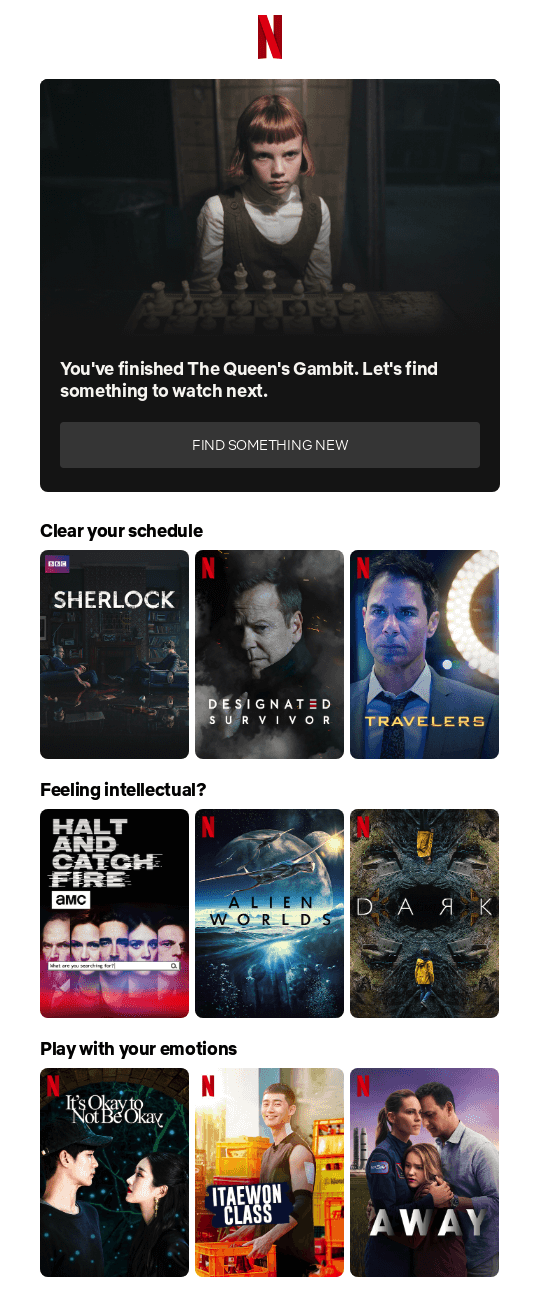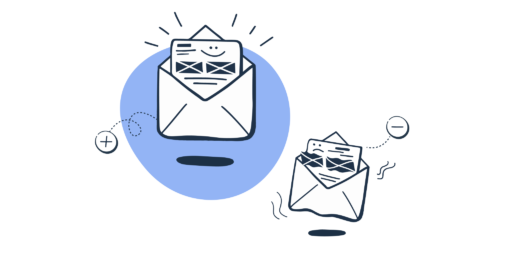Dynamic email content represents part of an email that changes based on the subscriber’s behavior, demographics, history, or preferences. It is a mass message that speaks directly and personally to users based on the information they’ve provided.
As an email marketer, you should create personalized messages for your subscribers by taking certain factors — such as age, gender, location, and country — into consideration.
Dynamic email content enables marketers to do that by customizing specific aspects of an email — text, visuals, or call-to-action (CTA) — to target particular customers.
Its primary purpose is to connect the brand to its subscribers, as personalized emails produce a six times higher transaction rate than non-personalized emails.
Dynamic email content vs. personalization
Email personalization and dynamic email content appear alike, but they have their differences.
Many people think email personalization only involves inserting a customer’s first name at the beginning of an email — like “Dear John.” Well, it’s part of it, but there’s more to it than just that.
Personalization happens when you use specific details about a person in the email body or subject line to tailor your message. These details include their locations, birthdays, or products they purchased from you.
The more information you know about your target audience, the easier it is to create messages that speak directly to them. In addition, most email service providers (ESPs) support basic personalization capabilities to insert any element of your database into your emails.
On the other hand, dynamic email content is a sophisticated personalization. It is an advertising tool in which you change the email content according to subscribers in your database.
Dynamic email content delivers a single email in different ways using automation.
For example, Abby’s agency wants its subscribers to enjoy a 30-day free trial of its new product and check out its physical stores nearby. Instead of creating separate emails with basic personalization features to cater to each physical store, Abby creates a single dynamic email.
Unfortunately, many email service providers lack dynamic content capabilities.
Effective tools for dynamic email content
While you can use several tools to generate personalized messages, you need proper tools to develop dynamic content.
Here’s our list of the best software for preparing dynamic email content:
HubSpot: It enables you to create smart content for subscribers through personalized images, texts, CTAs, and other customizable elements. With this all-in-one marketing platform, you can effectively engage and manage your email audience.
Act-On: It is a marketing automation platform that shows dynamic content through features like text blocks, images, lists, CTAs, checkboxes, and downloads. It enables you to create email content based on subscribers’ preferences, transaction activities, and demographics.
Avari: It provides real-time predictive and personalized messages for your users. It offers plug-n-play dynamic content blocks for quick upgrades to your emails.
Cordial: It uses the internet, mobile applications, devices, and previous sales to build users’ profiles. Its context-aware messaging enables you to send emails based on subscribers’ recent behavior — like their browser activity.
Benefits of dynamic email content
Using dynamic email content to communicate with your subscribers can improve your email marketing strategy and overall digital marketing results.
Here are some of the reasons it’s important to use dynamic content in email marketing campaigns:
1. Refines customer experience
Regardless of your niche, services, or products, your customers expect nothing short of a top-notch customer experience.
80% of consumers prefer buying from a brand that offers personalized experiences. Through dynamic content marketing, you’ll be able to understand and target your customers’ needs, abilities, and pain points.
When your customers are connected and satisfied with the emails you send, it enhances their perceptions of your brand, which in turn leads to increased sales and revenue.
2. Improves productivity
Manually personalizing and segmenting the different aspects of your email list takes time and effort.
Dynamic email marketing helps you cut down that time and lets you focus on a more worthy task. Using automation and smart rules, you can easily align messages with subscribers’ data.
In this way, you achieve more in less time and can divert your time and energy to other essential areas of your marketing.
3. Raises conversion rate
Your audience’s data gives you insights that help you decide the products or services you should be promoting to them.
For instance, if you know your customers’ purchase history, you can create dynamic email content recommending products and services relevant to them.
The more aligned your emails are with their buying journey, the more leads you’ll make.
4. Engages your audience
Messages tailored to meet the specific needs of the recipients receive better attention than messages that highlight the general features of a product.
Send dynamic email content to your subscribers to engage your audience. Accentuate shares that 91% of consumers prefer shopping with brands that provide relevant offers and product recommendations.
Generating dynamic email content
To stand out from your competition, you need to create dynamic email content that captures your customers’ attention. To do so, you require information on your subscribers and what separates them from one another.
That’s why every dynamic email content plan consists of the following two steps:
1. Data Collection
Before you create dynamic email content for your users, you require comprehensive customer data, which you can get through the following methods:
- QR Codes – One of the easiest ways today to facilitate data collection is to create a QR Code for a Google form and share it on your product, website, or social media.
- Subscription forms – Include the fields you want your audience to fill in. Avoid asking for too much information that might put them off.
- Interview – Conduct face-to-face or online interviews with your customers. Get to know their needs, interests, and expectations from your brand. You can even record these interviews professionally and use the content in retargeting campaigns.
- Customer feedback – Create a survey for customer feedback after they’ve purchased your products using survey form tools like HubSpot Forms, JotForm, SurveyMonkey. You can also use your sales CRM or live chat software.
- Community research – Check for keywords, polls, and search queries from major social media platforms. If you can, don’t hold back from leveraging social media analytics tools to gather more comprehensive data.
2. Segmentation
Segmented campaigns can get you as much as a 760% ROI increase.
Categorizing subscribers with common needs into groups enables you to focus on their interests and get higher engagement.
When you determine the right group for your recipients, it is best to tailor your email content according to the customer lifecycle — from reaching out to a potential buyer to retaining a loyal customer.
Segmentation gives you insights into engagement strategies to deal with each customer. For instance, your email to new subscribers may include brief details about your products.
Customizing your email for each segment
You have to consider different variables when personalizing your email content for target consumers.
Typical variables to consider when looking to create dynamic email content include:
1. Demographics
It includes:
- Personal information
- Gender
- Age
- Race
- Marital status
- Religion
- Financial information
- Educational level
- Profession
- Employment status
- Income
- Accessory information
- Location
- Household size
2. Psychographics
It deals with the interests, habits, values, and principles of your target customers. For example, psychographics help you tailor messages to align with subscribers’ hobbies, fashion style, or food choices.
You can collect this data through email surveys, quiz builders, or customer interviews.
3. Subscribers’ preferences
Give your subscribers an option to express their content preferences when signing up for your newsletter.
4. Customer behavior
It covers your subscriber’s purchase behavior, website activity, and email engagement.
Netflix is a great example here of a service that delivers personalized content in emails, based on their users’ behavior. When new shows are released, Netflix notifies users who previously watched similar content.

Another similar example is Amazon. They often recommend new or related products based on their customers’ browsing history. In the case below, I wasn’t actively looking for David Ogilvy’s book, but I had been browsing for marketing and advertising books so Amazon sent a related product as a recommendation.
Types of dynamic email content
You can share the following content in your dynamic emails to your subscribers:
Text
First-time email marketers often use this type of dynamic email content. It’s a simple and effective way to customize your message for different potential buyers. It includes varying subject lines and paragraphs according to the customer.
Visuals
You can include images, videos, or GIFs or digital brochures in your email content. When selecting the media for your email, ensure that it resonates with your subscribers to evoke the correct response from them. You can also use a professional photo editing tool or AI headshot generators to help you with that. For example, upscaling images will make your images pop in your email more.
Call to action (CTA)
The goal of a CTA is to grab your subscribers’ attention and encourage them to take a specific action, leading to more sales for your brand. One way to do that is to include CTAs and your contact details in your digital business card to help potential customers reach out directly.
Adding dynamic content to emails
The exact process for adding dynamic email content differs from one email service to another.
Still, most email marketing services enable you to add variables — for changing dynamic email content — to any part of your email, including subject lines, text, images, and calls-to-action.
When adding a variable, don’t forget the users without any record, as you can alienate them by mishandling this lack of data.
To avoid this, automatically substitute an empty field with default information using preset criteria. For example, instead of “your Nike shoes,” say “your shoes.”
Dynamic email subject lines
The subject line is an essential part of your email as it determines whether or not a user will open it.
According to HubSpot, customers tend to open emails that have their first names in the subject lines. To benefit from that, personalize your subject lines by adding the name variable to them.
Dynamic email body
You can start with a dynamic email template and add different variables as you like. You can define the place where you want to display dynamic text or add dynamic CTAs and images.
You can set the requirements — gender, city, or age criteria — for segmentation.
Common mistakes when using dynamic email content
Dynamic email content gets you the desired results if you execute it well. Still, you can jeopardize your marketing plans by mistake.
Some of the common mistakes marketers make when creating dynamic email content are:
Inaccurate data
If you address senior citizens like young adults in your email, it won’t produce the desired outcome. To avoid that, scrutinize your customer data and segment them carefully. Also, ask subscribers to update their email preferences regularly.
Failure in tracking metrics
A successful dynamic email content strategy requires you to gauge the performance of an email after sending it. You need to analyze the click-through rates of different links to verify your subscribers’ activity and interests.
Overuse of multiple dynamic email content types
Using all the available features may be tempting. But including multiple content blocks in your emails will distract you from focusing on the personalized content your audience needs.
It is best to change only one or two dynamic content blocks per email.
Dynamic email content examples
Below are some inspiring dynamic email examples to take note of:
- Sports equipment companies and fitness enterprises personalize content based on their subscribers’ location and the current weather conditions, so consumers visualize themselves using their products.
These brands enrich their emails by including CTA buttons for rainy days and hot weather.
- Spotify tailors its newsletter to reflect the recipient’s music preferences, thereby prioritizing everyone’s differences in music taste.
- Netflix recommends movies to customers based on their preferred genre and favorite movies.
- Skyscanner recommends flights or hotels based on the users’ location and season.
Final thoughts: Dynamic email content — What you need to know
Dynamic email content delivers valuable and relevant content to your subscribers. With personalized emails, your subscribers connect with you and your brand. You engage with your audience to build a long-lasting relationship with them, leading to an increase in sales. Plus, if you pair dynamic emails with some interactive email content, you can significantly enhance user engagement and improve the overall customer experience.
Check out our other posts to learn more about email marketing.



